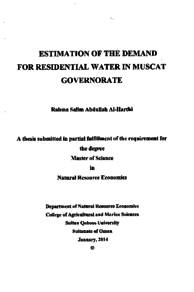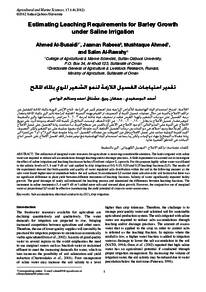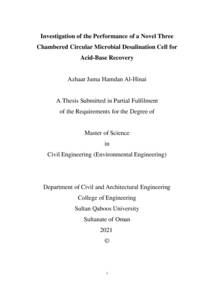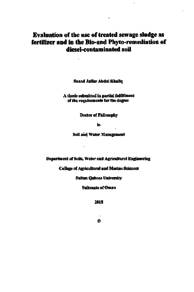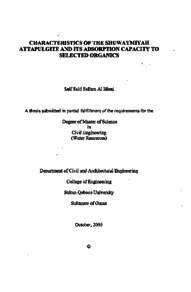Document
Estimation of the demand for residential water in Muscat governorate
Publisher
Sultan Qaboos University
Gregorian
2014
Language
English
Subject
English abstract
The increase in residential water demand is a challenging issue for the world and for Oman specifically as it is located in an arid region. Oman has continuously increased water supply through desalination to fill the rapid increases in water demand. However, no significant effort was done to manage the demand. The desalination is considered expensive option in solving the increase in water demand compared to water demand management. Thus, to manage the consumers demand, it is important to conduct a research to study the demand for water and the factors affecting its consumption. Therefore, this study estimates the water demand function in Muscat Governorate and identifies the main factors that affect water consumption.
The data used in the study was generated from a household survey conducted at Al-Seeb and Al-Qurum of Muscat Governorate counting 266 households. The dependent variable used in the analysis is the average monthly household water consumption and the independent variables are household income, number of residents, number of potted plants in the garden, presence of swimming pool, frequency of car washing, presence of modern irrigation system and the size of irrigated area in the garden.
Alternative econometric models were used to estimate the residential water demand. The econometric models used in the study are two stage least squire (2SLS) and lagged average price model. Results showed that the water users react to the lagged average price rather than the current average price.
The findings of the study are consistent with results reported in the literature. The price and income are significant variables in determining the demand for water. The other variables included in the model such as number of home residents, number of potted plants in the garden, presence of swimming pool and the frequency of car washing are significant variables in determining water demand in Muscat Governorate. The demand for water is price elastic. The price elasticity was estimated to be -2.1. This is expected, since part of the water users uses the water for outdoor purposes such as gardening, swimming and washing their own cars. Most of the consumers don't use the tap water for drinking; they tend to buy bottled water for drinking purposes. The income elasticity is estimated at 0.04 showing that the demand for water is income inelastic. The findings indicate that managing demand for water in Muscat Governorate through economic instruments (eg: increase the price) is recommended, besides to increasing water supply through desalination.
Description
Thesis
Member of
Resource URL
Arabic abstract
تزايد الطلب على المياه السكنية يعد مشكلة عالمية ومحلية على حد سواء. وبحكم موقع سلطنة عمان الجغرافي في المناطق القاحلة من العالم أصبحت هذه المشكلة تتفاقم من سنة إلى أخرى. وقد قامت السلطنة ممثلة بالجهات المعنية بسد الثغرة الناتجة بين الطلب والإنتاج بزيادة كميات المياه المحلاة من البحر وفي المقابل ليست هناك جهود فعالة تذكر لإدارة الطلب على المياه. وفي المقابل يعتبر الحل المتبع لتغطية الزيادة في الطلب الخيار الأكثر كلفة مقارنة بإدارة الطلب على المياه ولذلك أصبح من المهم دراسة الطلب على المياه وتقدير العوامل التي تؤثر عليه. ومن هذا المنطلق تهدف هذه الدراسة إلى تقدير الطلب على المياه السكنية في محافظة مسقط وتحديد العوامل التي تؤثر عليه. البيانات المستخدمة في هذه الدارسة تم تجميعها لعينة تم اختيارها عشوائيا لأسر في ولايتي السيب والقرم في محافظة مسقط و حجم العينة المستخدمة هو 266 عينة. المتغير التابع في النموذج هو المتوسط الشهري للمياه المستهلكة من قبل الأسرة وأما بالنسبة للمتغيرات المستقلة المستخدمة هي دخل الأسرة وعدد المقيمين في المنزل, وعدد الأصائص المزروعة في الحديقة المصاحبة للمنزل, وتواجد حوض السباحة وعدد المرات التي يتم تنظيف السيارات في المنزل, وتواجد نظام الري الحديث وحجم المساحة المرورية في حديقة المنزل. هناك العديد من النماذج الاقتصادية القياسية تستخدم لتقدير الطلب على المياه , وفي هذه الدراسة النموذج الاقتصادي القياسي الذي تم استخدامه لتحليل البيانات هما طريقة المربعات الصغرى على مرحلتين (2SLS) و متوسط تأخر السعر (lagged average price). وقد أوضحت النتائج أن مستهلكي المياه يستجيبون لمتوسط تأخر السعر مقارنة بالسعر الحالي للمياه. نتائج الدراسة كانت متفقة مع النتائج التي وردت في الدراسات السابقة, حيث أوضحت نتائج النموذج أن سعر المياه ودخل الأسرة يعتبران عاملان مهمان في تحديد الطلب على المياه، وهناك عدة عوامل أخرى أيضا تم إدراجها في النموذج الاقتصادي القياسي وقد كشفت النتائج على أنها عوامل هامة جدا في تحديد الطلب على المياه، مثل عدد المقيمين في المنزل, وعدد الأصائص المزروعة في الحديقة المصاحبة للمنزل, وتواجد حوض السباحة وعدد المرات التي يتم تنظيف السيارات في المنزل عن طريق المياه الموصلة بشبكة المياه الحكومية. بالإضافة إلى ذلك أوضحت النتائج مرونة الطلب السعرية للمياه تم حسابها بما يعادل - 2 . 1 حيث أنها مرنة لتغير السعر ؛ هذه النتيجة متوقعة وذلك لأن بعض المستهلكين يستخدمون جزء من هذه المياه للاستخدامات الخارجية وغير الضرورية وكذالك يفضل معظم المستهلكين شراء المياه المعبأة لأغراض الشرب. وبالنسبة لمرونة الطلب الدخلية قدرت ب 0 . 04 مما يوضح أن الطلب على المياه غير مرن لتغير دخل الأسرة. وتوصي هذه الدراسة إلى أن إدارة الطلب على المياه من خلال الأدوات الاقتصادية من حيث التحكم بسعر الماء يعتبر حلا أمثلا لإدارة الطلب على المياه بالإضافة إلى زيادة كمية المياه المحلاة.
Category
Theses and Dissertations

